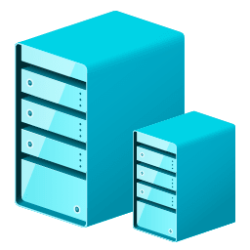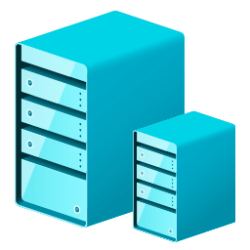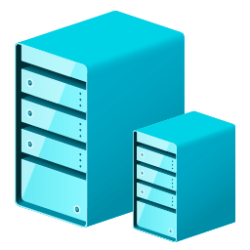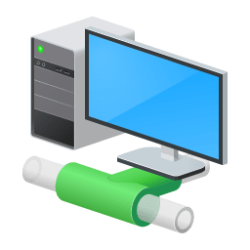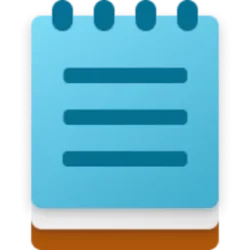This tutorial will show you how to restore a checkpoint for a Hyper-V virtual machine in Windows 10 and Windows 11.
Hyper-V enables running virtualized computer systems on top of a physical host. These virtualized systems can be used and managed just as if they were physical computer systems, however they exist in virtualized and isolated environment. Special software called a hypervisor manages access between the virtual systems and the physical hardware resources. Virtualization enables quick deployment of computer systems, a way to quickly restore systems to a previously known good state, and the ability to migrate systems between physical hosts.
One of the great benefits to virtualization is the ability to easily save the state of a virtual machine. In Hyper-V this is done through the use of virtual machine checkpoints when enabled. You may want to create a virtual machine checkpoint before making software configuration changes, applying a software update, or installing new software. If a system change were to cause an issue, the virtual machine can be reverted to the state at which it was when then checkpoint was taken.
Hyper-V includes two types of checkpoints:
- Standard Checkpoints: takes a snapshot of the virtual machine and virtual machine memory state at the time the checkpoint is initiated. A snapshot is not a full backup and can cause data consistency issues with systems that replicate data between different nodes such as Active Directory. Hyper-V only offered standard checkpoints (formerly called snapshots) prior to Windows 10.
- Production Checkpoints: uses Volume Shadow Copy Service or File System Freeze on a Linux virtual machine to create a data-consistent backup of the virtual machine. No snapshot of the virtual machine memory state is taken.
When you enable checkpoints for a virtual machine, you can also manually create a checkpoint for the virtual machine on demand as needed.
If you want to revert your virtual machine to a previous point-in-time, you can apply an existing checkpoint.
Reference:

You must be signed in as an administrator to restore a checkpoint for a Hyper-V virtual machine.
- Option One: Revert Hyper-V Virtual Machine to Previous Checkpoint in Hyper-V Manager
- Option Two: Apply Selected Checkpoint to Hyper-V Virtual Machine in Hyper-V Manager
- Option Three: Apply Selected Checkpoint to Hyper-V Virtual Machine in PowerShell
1 Open Hyper-V Manager (virtmgmt.msc).
2 Select the virtual machine (ex: "Windows 11 Home") in the middle pane you want to revert to its previous checkpoint. (see screenshot below step 3)
3 Perform one of the following actions below to revert to the checkpoint: (see screenshot below)
- Click/tap on Revert in the right "Actions" pane.
- Click/tap on Action on the menu bar, and click/tap on Revert.
- Right click on the virtual machine in the middle pane, and click/tap on Revert.
4 Click/tap on Revert to confirm. (see screenshot below)
5 You can now close Hyper-V Manager if you like.
1 Open Hyper-V Manager (virtmgmt.msc).
2 Select the virtual machine (ex: "Windows 11 Home") in the middle pane you want to apply an existing checkpoint. (see screenshot below step 4)
3 Select an existing checkpoint in the middle pane you want to revert the virtual machine to. (see screenshot below step 4)
4 Perform one of the following actions below to apply the checkpoint: (see screenshot below)
- Click/tap on Apply in the right "Actions" pane.
- Click/tap on Action on the menu bar, and click/tap on Apply.
- Right click on the checkpoint in the middle pane, and click/tap on Apply.
5 Click/tap on either Create Checkpoint and Apply or Apply to confirm. (see screenshot below)
Create Checkpoint and Apply: Creates a new checkpoint of the virtual machine before it applies the earlier checkpoint.
Apply: Applies only the checkpoint that you have chosen. You cannot undo this action.
Cancel: Closes the dialog box without doing anything.
6 You can now close Hyper-V Manager if you like.
1 Open Windows Terminal (Admin), and select Windows PowerShell.
2 Type the command below into Windows Terminal (Admin), and press Enter to see a list of all available checkpoints for a virtual machine. (see screenshot below step 3)
Get-VMCheckpoint -VMName "<VM Name>"Substitute <VM Name> in the command above with the actual virtual machine name (ex: "Windows 11 Home") you want to apply a checkpoint.
For example: Get-VMCheckpoint -VMName "Windows 11 Home"
3 Make note of the checkpoint name (ex: "Windows 11 Home - (5/31/2024 - 11:01:16 AM)") you want to apply to this virtual machine (ex: "Windows 11 Home"). (see screenshot below)
4 Type the command below into Windows Terminal (Admin), and press Enter. (see screenshot below)
Restore-VMCheckpoint -Name "<Checkpoint Name>" -VMName "<VM Name>" -Confirm:$falseSubstitute <Checkpoint Name> in the command above with the actual checkpoint name (ex: "Windows 11 Home - (5/31/2024 - 11:01:16 AM)") from step 3 you want to apply to its virtual machine.
Substitute <VM Name> in the command above with the actual virtual machine name (ex: "Windows 11 Home") you want to apply its checkpoint.
For example: Restore-VMCheckpoint -Name "Windows 11 Home - (5/31/2024 - 11:01:16 AM)" -VMName "Windows 11 Home" -Confirm:$false
5 You can now close Windows Terminal (Admin) if you like.
That's it,
Shawn Brink
- Enable or Disable Checkpoints for Hyper-V Virtual Machine in Windows 11
- Enable or Disable Automatic Checkpoints for Hyper-V Virtual Machine in Windows 11
- Create Checkpoint for Hyper-V Virtual Machine in Windows 11
- Rename Checkpoint for Hyper-V Virtual Machine in Windows 11
- Delete Checkpoints for Hyper-V Virtual Machine in Windows 11
- Import Hyper-V Virtual Machine in Windows 11


